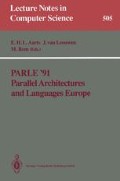Abstract
The dataflow model and control-flow model are generally viewed as two extremes of computation models on which a spectrum of architectures are based.
In this paper, we present a hybrid architecture model which employs conventional architecture techniques to achieve fast pipelined operation, while exploiting fine-grain parallelism by data-driven instruction scheduling. A mechanism for supporting concurrent operations of multiple instruction threads on the hybrid architecture model is presented and a compiling paradigm for dataflow software pipelining which efficiently exploits loop parallelism in loops is outlined. Simulation results attest that hybrid evaluations can indeed be beneficial.
Access this chapter
Tax calculation will be finalised at checkout
Purchases are for personal use only
Preview
Unable to display preview. Download preview PDF.
References
Arvind and D. E. Culler. Dataflow architectures. Annual Reviews in Computer Science, 1: 225–253, 1986.
Arvind and Robert A. Iannucci. Two fundamental issues in multiprocessing. In Parallel Computing in Science and Engineering, pages 61–88. Springer-Verlag, LNCS295, 1987. Proceedings of the.4th International DFVLR Seminar on Foundations of Engineering Sciences, Bonn, June 1987.
D. E. Culler. Managing parallelism and resources in scientific dataflow programs, Ph.D thesis. Technical Report TR-446, Laboratory for Computer Science, MIT, 1989.
J. B. Dennis. First version of a data-flow procedure language. In Proceedings of the Colloque sur la Programmation, volume 19 of Lecture Notes in Computer Science, pages 362–376. Springler-Verlag, 1974.
J. B. Dennis and G. R. Gao. An efficient pipelined dataflow processor architecture. In Joint Conference on Supercomputing,pages 368–373, Florida, November 1988. IEEE Computer Society and ACM SIGARCH.
G. R. Gao. A Code Mapping Scheme for Dataflow Software Pipelining. Kluwer Academic Publishers, Boston, December 1990.
G. R. Gao, H. H. J. Hum, and Y. B. Wong. An efficient scheme for fine-grain software pipelining. In Proceedings of the CONPAR ‘80—VAPP IV Conference, Zurich, September 1990.
G. R. Gao, H. H. J. Hum, and Y. B. Wong. Parallel function invocation in a dynamic argument-fetching dataflow architecture. In Proceedings of the PARBASE ‘80 Conference, Miami Beach, FL, March 1990.
G.R. Gao and Qi Ning. Loop storage optimization for dataflow machines. ACAPS Technical Memo 23, School of Computer Science, McGill University, Montréal, Qué., February 1991. In preparation.
V. G. Grafe, G. S. Davidson, J. E. Hoch, and V. P. Holmes. The Epsilon dataflow processor. In Proceedings of the 16th International Symposium on Computer Architecture, pages 36–45, Israel, June 1989.
J. R. Gurd, C. C. Kirkham, and I. Watson. The Manchester prototype dataflow computer. Communications of the ACM, 28 (1): 34–52, January 1985.
H. H. J. Hum and G. R. Gao. A novel high-speed memory organization for fine-grain multi-thread computing. In in the same Proceedings, June 1991.
R. A. Iannucci. Toward a dataflow/von Neumann hybrid architecture. In Proceedings of the 15th Annual International Symposium on Computer Architecture, pages 131–140. ACM, June 1988.
D. Kuck, E. Davidson, D. Lawrie, and A. Sameh. Parallel supercomputing today and the cedar approach. Science Magazine, 231: 967–974, February 1986.
S. Y. Kung, S. C. Lo, and P. S. Lewis. Timing analysis and optimization of VLSI data flow arrays. In Proceedings of the 1986 International Conference on Parallel Processing, 1986.
J.M. Monti. Interprocessor communication supports for a multiprocessor dataflow machine. Master’s thesis, School of Computer Science, McGill University, Montré;al, Qué;, March 1991.
R. Nikhil and Arvind. Can dataflow subsume von Neumann computing? In Proceedings of the 16th International Symposium on Computer Architecture, pages 262–272, Israel, 1989.
G. M. Papadopoulos and D. E. Culler. Monsoon: An explicit token-store architecture. In Proceedings of the Seventeenth Annual International Symposium of Computer Architecture, Seattle, Washington, pages 82–91, 1990.
Burton Smith. The architecture of HEP. In J. S. Kowalik, editor, Parallem MIMD Computation: HEP Supercomputer and its Application, pages 41–55. The MIT Press, 1985.
K. R. Traub. Sequential implementation of lenient programming languages. Technical Report MIT/LCS/TR-417, Laboratory for Computer Science, MIT, 1988.
Author information
Authors and Affiliations
Editor information
Editors and Affiliations
Rights and permissions
Copyright information
© 1991 Springer-Verlag Berlin Heidelberg
About this paper
Cite this paper
Gao, G.R., Hum, H.H.J., Monti, JM. (1991). Towards an Efficient Hybrid Dataflow Architecture Model. In: Aarts, E.H.L., van Leeuwen, J., Rem, M. (eds) Parle ’91 Parallel Architectures and Languages Europe. Lecture Notes in Computer Science, vol 505. Springer, Berlin, Heidelberg. https://doi.org/10.1007/978-3-662-25209-3_24
Download citation
DOI: https://doi.org/10.1007/978-3-662-25209-3_24
Publisher Name: Springer, Berlin, Heidelberg
Print ISBN: 978-3-662-23206-4
Online ISBN: 978-3-662-25209-3
eBook Packages: Springer Book Archive

